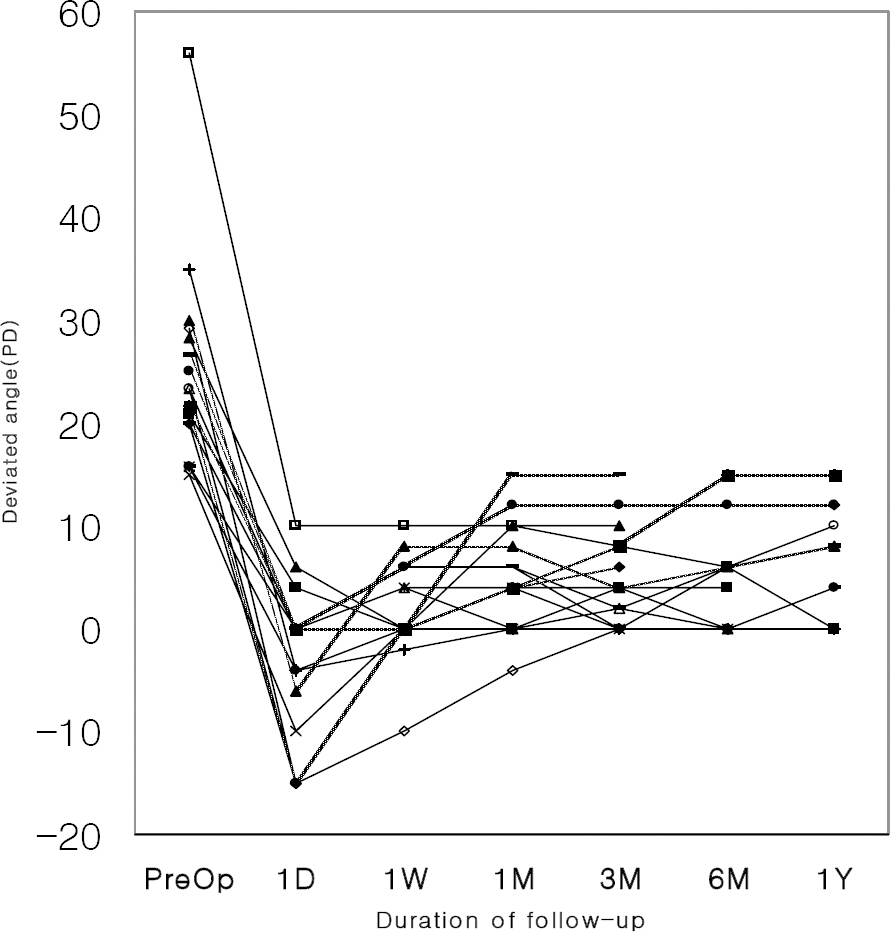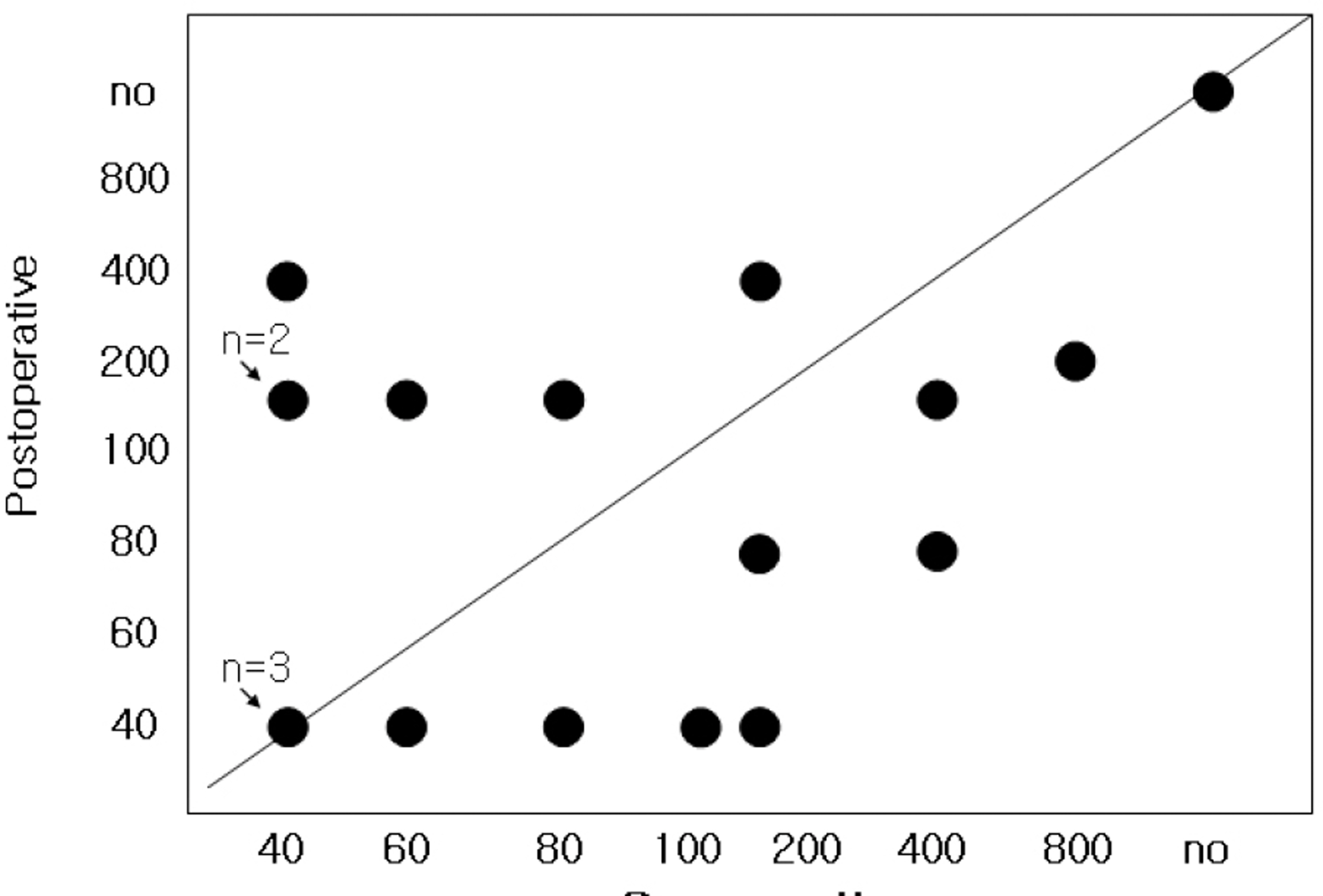J Korean Ophthalmol Soc.
2008 Jul;49(7):1120-1126. 10.3341/jkos.2008.49.7.1120.
The Surgical Outcomes of Exotropia in Children with a Short Preoperative Work-Up
- Affiliations
-
- 1Department of Ophthalmology, Chungbuk National University School of Medicine, Cheongju, Korea. mychoi@chungbuk.ac.kr
- 2Chungbuk National University Medical Research Institute, Cheongju, Korea.
- KMID: 1476967
- DOI: http://doi.org/10.3341/jkos.2008.49.7.1120
Abstract
-
PURPOSE: We performed this study to evaluate the surgical outcome of exotropia in children younger than 10 years with a short, preoperative work-up.
METHODS
The study subjects included 18 children who had received surgery for exotropia with preoperative work-ups less than 3 months. They were followed for more than 3 months after surgery. The age, symptoms, visual acuity, refractive errors, binocularity at surgery, and surgical results were analyzed.
RESULTS
The average age of the subjects was 9.6 years old, and the preoperative angle of deviation was 25 prism diopters (PD). Most of them (89%) showed intermittent exotropia and myopia. None of them had amblyopia or anisometropia. Of the 18 patients, 16 (89%) were able to fuse at near and distance, and 14 patients showed good stereopsis equal to or less than 200 sec of arc by the Titmus test. The surgery was performed on the basis of the maximum angle, and inferior oblique myectomy was simultaneously performed in three patients. At the postoperative 15 months, 13 (72%) of the 18 patients showed a deviated angle less than 10PD, and exotropia recurred in 5 (28%) patients.
CONCLUSIONS
The preoperative visual acuity and binocularity were relatively good, and the surgical outcome was also good in exotropic children younger than 10 years with a short preoperative work-up.
MeSH Terms
Figure
Reference
-
References
1. von Noorden GK. Binocular vision and ocular motility. Theory and management of strabismus. 2002. 6th ed. St. Louis: Mosby;p. 356–76.2. Jung MS, Choi MY. The natural course in children with intermittent exotropia. J Korean Ophthalmol Soc. 2003; 44:1572–7.3. Burian HM, Spivey BE. The surgical management of exodeviations. Am J Ophthalmol. 1965; 59:603–20.4. Metz HA. Complications following surgery for thyroid ophthalmopathy. J Pediatr Ophthalmol Strabismus. 1984; 21:220–2.
Article5. Dunn WJ, Arnold AC, O'Connor PS. Botulinum toxin for treatment of dysthyroid ocular myopathy. Ophthalmology. 1986; 93:470–5.6. Kim HS, Lee JB, Han SH. Nontraumatic acquired paralytic strabismus. J Korean Ophthalmol Soc. 1994; 35:1127–31.7. Kim YH, Rah SH, Lee JH. Surgical results of intermittent exotropia in pediatric versus adult group. J Korean Ophthalmol Soc. 1998; 39:1264–70.8. Kwak MS, Kwon YK, Kim SY. A clinical study on exodeviation. J Korean Ophthalmol Soc. 1994; 35:95–102.9. Lee JH, Son KH. The clinical study on the 453 surgical cases of exotropia. J Korean Ophthalmol Soc. 1994; 35:1437–45.10. Hardesty HH, Boynton JR, Keenan JP. Treatment of intermittent exotropia. Arch Ophthalmol. 1978; 96:268–74.
Article11. Pratt-Johnson JA, Parks MM, Tilson G. Early surgery for intermittent exotropia. Am J Ophthalmol. 1977; 84:689–94.12. Kim MM, Cho ST. Long-term surgical results of intermittent exotropia. J Korean Ophthalmol Soc. 1994; 35:1321–6.13. Cho YA, Lee JK. Early surgery before 4 years of age in intermittent exotropia. J Korean Ophthalmol Soc. 2004; 45:620–5.14. Paik HJ, Sohn HJ. Early surgery for intermittent exotropia in children less than 4 years of age. J Korean Ophthalmol Soc. 2006; 47:477–83.15. Scott WE, Keech RV, Mash J. The postoperative results and stability of exodeviations. Arch Ophthalmol. 1981; 99:1814–8.
Article16. Richard JM, Parks MM. Intermittent exotropia: surgical results in different age groups. Ophthalmology. 1983; 90:117–7.17. Ko KH, Min BM. Factors related to surgical results of intermittent exotropia. J Korean Ophthalmol Soc. 1996; 37:179–84.18. Park HJ, Paik HJ. Comparison of surgical results between bilateral recession and unilateral resection-recession in intermittent exotropia. J Korean Ophthalmol Soc. 2003; 44:911–6.19. Mun HJ, Kim MM. Comparison of surgical results between bilateral recession and unilateral recession-resection in 25 PD intermittent exotropia. J Korean Ophthalmol Soc. 2002; 43:2202–7.20. Keenan JM, Willshaw HE. The outcome of strabismus surgery in childhood exotropia. Eye. 1994; 8:632–7.
Article21. Schlossman A, Muchnick RS, Stern KS. The surgical management of intermittent exotropia in adult. Ophthalmology. 1983; 90:1166–71.22. Lee SY, Oh JS, Kim SJ. The clinical characteristics and surgical results in the intermittent exotropia more than 15 years of age. J Korean Ophthalmol Soc. 1997; 38:1056–63.23. Scott AB, Marsh AJ, Jampolsky A. Quantitative guidelines for exotropia surgery. Invest Ophthalmol Vis Sci. 1975; 14:428–36.24. Kim HY, Chang BL. Clinical evaluation of exotropia combined with amblyopia in children. J Korean Ophthalmol Soc. 1996; 37:662–8.25. Vries JD. Anisometropia in children, analysis of a hospital population. Br J Ophthalmol. 1985; 69:504–7.26. Wilson ME, Parks MM. Primary inferior oblique in congenital esotropia, accommodative esotropia, and intermittent exotropia. Ophthalmology. 1989; 96:950–6.27. Choi DG, Kim PS. The surgical outcome of intermittent exotropia and the prognostic factors. J Korean Ophthalmol Soc. 1998; 39:1255–63.28. Abroms AD, Mohney BG, Rush DP. . Timely surgery in intermittent and constant exotropia for superior sensory outcome. Am J Ophthalmol. 2001; 131:111–6.
Article29. Beneish R, Flanders M. The role of strabismus and early postoperative alignment in long-term surgical results of intermittent exotropia. Can J Ophthalmol. 1994; 29:119–24.30. Gill MK, Drummond GT. Indications and outcomes of strabismus repair in visually mature patients. Can J Ophthalmol. 1997; 32:436–40.
- Full Text Links
- Actions
-
Cited
- CITED
-
- Close
- Share
- Similar articles
-
- The Comparison of Long-term Surgical Results for Sensory Exotropia and Comitant Exotropia
- Variability of Preoperative Angle of Deviation Measured on the Day of Surgery in Intermittent Exotropia
- Surgical Outcomes in Patients with Intermittent Exotropia with Siblings Who Underwent Surgery by the Same Surgeon
- Related Factors of Surgical Outcome of Unilateral R and R for Basic Type Intermittent Exotropia in Children
- Changes in Types of Recurrent Intermittent Exotropia after Surgical Correction of Basic Type Intermittent Exotropia




